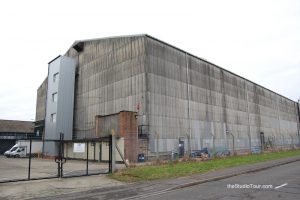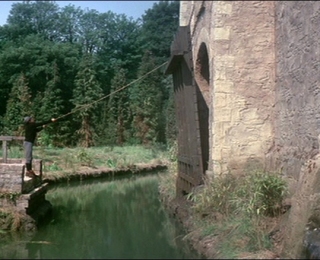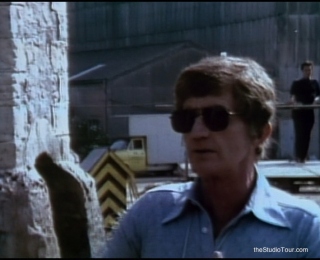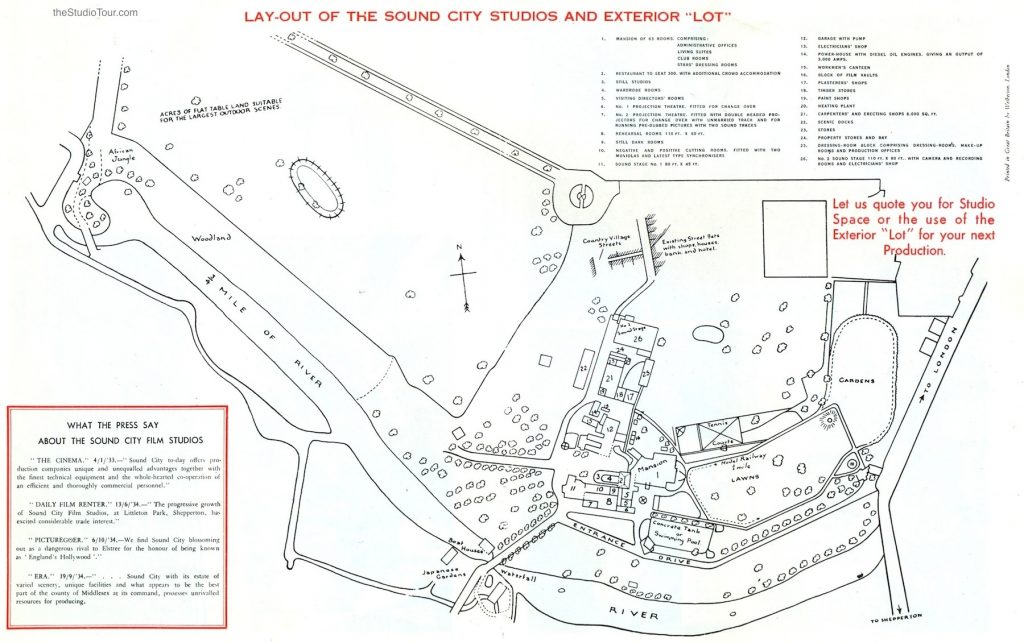This studio complex in leafy London suburb Shepperton is now part of the Pinewood Studios Group (along with Pinewood Studios and Teddington Studios).
In common with many studios, the former expansive backlot was sold off to raise revenue. Surrounding the studios now is a housing estate, with cinematically-related road names being the only clue to the history.
In July 2019, Netflix was announced as taking over all of the production facilities in a 10 year deal.
From the website:
Built around an exquisite manor house, its 14 stages, 10 acres of backlot and thousands of square feet of workshop space, continue to attract the most inspirational content creators. Production support services, a media hub and access to award-winning talent, make Shepperton an ideal base for all types of production.
Official Shepperton Studios website
Productions shot at Shepperton Studios
Stages
In the 1930s, when it was known as Sound City, there were two sound stages:
- Sound Stage No. 1 (80ft. x 45ft.)
- Sound Stage No. 2 (110ft. x 80ft. with camera and recording rooms and electricians shop).
The Sound City brochure from around 1935/6 says “These stages are provided with modern lighting equipment and the new system of Tubular Scaffolding – 2 Mobile Sound Vans of Marconi Vistatone non-royalty recording; 4 Studio Cameras on “Dollys,” including the latest 1935 model Debrie; Synchronous Back Projection and Play Back.”
Until the expansion (below), stages were:
- A Stage
- B Stage
- C Stage
- E Stage
- F Stage
- H Stage
- J Stage
- K Stage
- S Stage
- T Stage
- Backlot
[UNDER CONSTRUCTION DECEMBER 2023 – MORE COMING SOON]
2022/23 Expansion
New £500m expansion opened in June 2023, making it the second biggest studio in the world. The development includes a further 17 stages (around 1.2 million square feet), with all of the new space leased to Netflix and Amazon Prime.
Present Day:
C Stage
Seen on Screen: Shepperton Studios [C_Stage]
| Title | Released | Director | IMDB |
|---|---|---|---|
| Superman [Feature Film] | 1978 | Richard Donner |  |
| Principal photography began on 28 March 1977. C Stage: Jor-Els chamber and the Destruction of Krypton (start of filming). H Stage: Fortress of Solitude, filmed in May 1977 | |||
| The Princess Bride [Feature Film] | 1987 | Rob Reiner |  |
| Although much of the movie was shot on location around England, some key scenes were shot on soundstages at Shepperton. The fire swamp was shot on H Stage, and the clifftop duel on C Stage. The final kiss was on D Stage. The storytelling scenes in the bedroom were shot on L Stage. Miracle Maxs house was on M Stage. | |||
| Gravity [Feature Film] | 2013 | Alfonso Cuarón |  |
| B Stage, C Stage, R Stage, S Stage, T Stage and W Stage | |||
| Mary Poppins Returns [Feature Film] | 2018 | Rob Marshall |  |
| H Stage (Cherry Tree Lane), D Stage (Interior of Banks home), C Stage (Interior of Topsys house), J Stage (bluescreen/greenscreen scenes with physical sets), K Stage (bluescreen / greenscreen scences with physical sets) | |||
H Stage
At 45 feet (13.7m) high, H Stage is the largest at Shepperton and offers 30,000 square feet (2787 sqm) of space.
It’s 250 feet (76m) long and 120 feet (37m) wide. It also contains a 25 feet (8m) x 12 feet (4m) tank which is 3 feet (1m) deep. 
H Stage, Shepperton
Seen on Screen: Shepperton Studios [H_Stage]
| Title | Released | Director | IMDB |
|---|---|---|---|
| Star Wars: Episode IV - A New Hope [Feature Film] | 1977 | George Lucas |  |
| Three scenes (The Massassi Temple ceremony at the end of the film, the Rebel Briefing Room and the monitoring of the attack on the Death Star scene) were shot at Shepperton, due to the larger H Stage being needed for the temple scene. The main base of the film was Elstree Studios. | |||
| Superman [Feature Film] | 1978 | Richard Donner |  |
| Principal photography began on 28 March 1977. C Stage: Jor-Els chamber and the Destruction of Krypton (start of filming). H Stage: Fortress of Solitude, filmed in May 1977 | |||
| The Princess Bride [Feature Film] | 1987 | Rob Reiner |  |
| Although much of the movie was shot on location around England, some key scenes were shot on soundstages at Shepperton. The fire swamp was shot on H Stage, and the clifftop duel on C Stage. The final kiss was on D Stage. The storytelling scenes in the bedroom were shot on L Stage. Miracle Maxs house was on M Stage. | |||
| The Crystal Maze [TV Series] | 1990 - 1995 | Lloyd Bettell-Higgins, Simon Tayler, David Bodycombe, Bob Thorne, Adam Howarth |  |
| H Stage | |||
| Cape Fear [Feature Film] | 1991 | Martin Scorsese |  |
| H Stage | |||
| Frankenstein [Feature Film] | 1994 | Kenneth Branagh |  |
| H Stage: The tank was used for the ship scenes, featuring a full-scale ship mounted on a gimbal, with water chutes and huge wind machines. The backlot was used for the Frankenstein mansion exteriors, and for an exterior street. | |||
| The Avengers: Age of Ultron [Feature Film] | 2015 | Joss Whedon |  |
| H Stage | |||
| Beauty and the Beast [Feature Film] | 2017 | Bill Condon |  |
| G Stage (Interior of Gastons tavern), H Stage (Dark forest), Backlot (The village was entirely built on the backlot). The production was based at Shepperton for many months. | |||
| Mary Poppins Returns [Feature Film] | 2018 | Rob Marshall |  |
| H Stage (Cherry Tree Lane), D Stage (Interior of Banks home), C Stage (Interior of Topsys house), J Stage (bluescreen/greenscreen scenes with physical sets), K Stage (bluescreen / greenscreen scences with physical sets) | |||
Backlot
The current backlot space available is 10 acres.
In common with many studios, the former expansive backlot was sold off to raise revenue. Surrounding the studios now is a housing estate, with cinematically-related road names being the only clue to the history.
Frankenstein (1994)
The exterior of the Frankenstein mansion was built on the backlot, along with a street set.
The Pink Panther Strikes Again (1976)
Still from the Panthermania documentary on the Pink Panther box set DVD, showing director Blake Edwards on the Shepperton Studios backlot adjacent to the Castle set which remained on the backlot for some years after production. This area is now a children’s play area and road at the rear of H Stage (see photo).
Shepperton Studios History
1689
Local nobleman, Thomas Wood, builds Littleton Park, a mansion house which still stands in the centre of the 60-acre Shepperton site more than 300 years later. The Woods live at Littleton Park for almost 200 years. Their home was grandiose and played host to many royal visitors.
1876
A devastating fire caused damage which took more than 25 years to put right. The house was restored by Sir Richard Burbridge who was the Managing Director of the world-famous department store Harrods, in central London. Burbridge refurbished the house using timber from the original Houses of Parliament.
1931
Norman Loudon, owner of Flicker Productions, buys Littleton Park House (built in 1689) with 60 acres of grounds, including a stretch of the River Ash at Shepperton. The studio facility opened for business in 1932 as the base of Flicker Productions, which produced popular ‘flick’ books of photographs. Mr Loudon had his sights set on full feature film production.
1932
Mr Loudon founds ‘Sound City Film Producing and Recording Studios’. That year, Sound City produced three shorts for MGM and two features (‘Watch Beverly’ and ‘Reunion’)
1934
Studio is renovated providing additional facilities including seven sound stages, twelve cutting rooms, three viewing theatres, scene docks and workshops. During this time the old house is refurnished to provide hotel and restaurant facilities.
Plan of the Sound City Lot around 1935 (click to enlarge):
1941
The studio is requisitioned by the Ministry of Defence, first as a sugar storage location, then later to create decoy aircraft and munitions for positioning in the Middle East.
1945
The studio reopens, and changes hands. Norman Loudon retires, and Sir Alexander Korda acquires 74% controlling interest over Sound City.
1946
Sound City is renamed the ‘British Lion Studio Company‘
1984
Lee International pays £3.6m for the studios and begin a programme of refurbishment, including the planning and construction of new workshops, completed in 1987. The studio is renamed Lee International, Shepperton.
1995
Ridley & Tony Scott acquire Shepperton.
2001
Pinewood Studios buys Shepperton from the Scott brothers to offer a larger studio complex to incoming productions.
2004
Pinewood Shepperton floats on the London Stock Exchange.
?date
The Old House is bought by Simply Networking Solutions
2008
New Gainsborough Building Opens at Shepperton
Housing workshops and open plan offices for film and TV productions located at the Studios, the top floor of this 60,000 sq foot building will be available for longer term occupation from companies within the media sector who will benefit from basing all or part of their operation at Shepperton.
The completion of the building is a major step in the first phase of Shepperton’s Masterplan, a joint venture with Morley to further develop the Studio’s facilities.
Says Pinewood Group’s CEO Ivan Dunleavy “Shepperton’s Gainsborough building will provide a new focal point for the UK’s creative industry, hosting world class film and TV production teams together with leading media specialists. We’re delighted the Culture Minister is attending to mark the occasion.”
Margaret Hodge commented “Outstanding productions need the best possible facilities, and this important new base for media companies will help ensure that Shepperton Studios continues to make a vital and sustained contribution to the success of our film, TV and commercial sectors.”
More about the Gainsborough Building
Sources:






